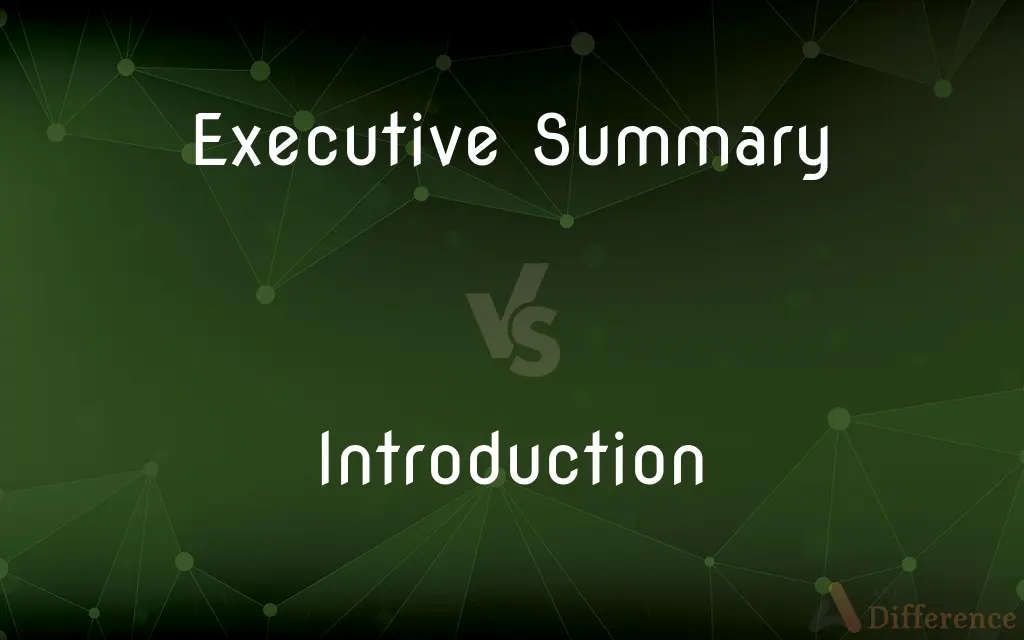Executive Summary vs. Introduction — What's the Difference?
Edited by Tayyaba Rehman — By Fiza Rafique — Published on December 31, 2023
Executive Summary condenses main points of a document, while Introduction sets the context and purpose.

Difference Between Executive Summary and Introduction
Table of Contents
ADVERTISEMENT
Key Differences
The Executive Summary and Introduction play distinct roles in any comprehensive document. The Executive Summary encapsulates the primary findings, conclusions, or recommendations of the report or document, aiming to provide a quick snapshot for readers who might not have the time or inclination to peruse the entire content. Contrarily, the Introduction serves as the gateway to the document, laying out the scope, context, and the overarching purpose it intends to serve.
Diving deeper, the Executive Summary is often crafted to suit higher-level stakeholders or decision-makers, presenting them with a concise overview of the document's essentials. This snapshot is beneficial for readers to understand the core essence without delving into the intricate details. In contrast, the Introduction paves the way for the detailed discourse that follows, establishing a foundational understanding and setting the stage for the readers, ensuring clarity on what to anticipate.
In business reports or academic research, the Executive Summary is typically found at the beginning, but it's often written last, after the full document is complete, ensuring all vital points are captured. Conversely, the Introduction, also placed at the beginning, is typically one of the first sections written, as it provides a roadmap for both the writer and the reader, highlighting the background, problem statement, or objectives.
Although both the Executive Summary and Introduction are crucial preliminary sections of any comprehensive document, they cater to different audiences and purposes. While the Executive Summary is a broad-strokes overview capturing the crux for a hurried reader, the Introduction provides depth, context, and a sense of direction, priming the reader for the forthcoming content.
Comparison Chart
Primary Purpose
Condense main findings, conclusions, or recommendations.
Set the context, background, and purpose of the document.
ADVERTISEMENT
Audience Focus
Targets decision-makers or those needing a quick overview.
Targets all readers to give a foundational understanding of the content.
Position in Document
Found at the beginning but often written last.
Placed at the beginning, typically written first.
Length
Relatively short, capturing the essence of the entire document.
Can be detailed, providing a thorough background and context.
Content Focus
Highlights key findings, results, or recommendations.
Lays out scope, objectives, and what the reader can expect in the document.
Compare with Definitions
Executive Summary
A section designed for decision-makers needing quick insights.
The CEO read the Executive Summary to understand the proposal's core recommendations.
Introduction
A segment that prefaces and outlines the main content.
The Introduction provided a roadmap for the subsequent chapters.
Executive Summary
A brief overview of a document's main points.
The Executive Summary provided a snapshot of the annual report's highlights.
Introduction
The initial part setting the tone and purpose of a piece.
Readers got a sense of the topic's significance from the Introduction.
Executive Summary
A synopsis summarizing the content and purpose of a document.
The Executive Summary clarified the report's objectives and primary conclusions.
Introduction
The foundational section priming readers on what to expect.
The Introduction set clear expectations for the audience regarding the content.
Executive Summary
A preliminary section encapsulating key information for swift comprehension.
The Executive Summary allowed stakeholders to quickly understand the project's status.
Introduction
A section providing background and context for a document.
The Introduction explained the historical context of the study.
Executive Summary
A condensed version capturing essential findings or conclusions.
Readers often turn to the Executive Summary to grasp the research's primary outcomes.
Introduction
The act or process of introducing or the state of being introduced.
Introduction
A means, such as a personal letter, of presenting one person to another.
Introduction
Something recently introduced; an innovation
"He loathed a fork.
It is a modern introduction which has still scarcely reached common people" (D.H. Lawrence).
Introduction
A preface, as to a book.
Introduction
(Music) A short preliminary passage in a larger movement or work.
Introduction
A basic introductory text or course of study.
Introduction
The act or process of introducing.
The introduction of a new product into the market
Introduction
A means, such as a personal letter, of presenting one person to another.
David was feeling groggy at his introduction to Sophie, and didn't remember her name.
Introduction
An initial section of a book or article, which introduces the subject material.
This book features a preface by a well-known botanist, and an introduction by the author's mentor at university.
Introduction
A written or oral explanation of what constitutes the basis of an issue.
Introduction
The act of introducing, or bringing to notice.
Introduction
The act of formally making persons known to each other; a presentation or making known of one person to another by name; as, the introduction of one stranger to another.
Introduction
That part of a book or discourse which introduces or leads the way to the main subject, or part; preliminary; matter; preface; proem; exordium.
Introduction
A formal and elaborate preliminary treatise; specifically, a treatise introductory to other treatises, or to a course of study; a guide; as, an introduction to English literature.
Introduction
The first section of a communication
Introduction
The act of beginning something new;
They looked forward to the debut of their new product line
Introduction
Formally making a person known to another or to the public
Introduction
A basic or elementary instructional text
Introduction
A new proposal;
They resisted the introduction of impractical alternatives
Introduction
The act of putting one thing into another
Introduction
The act of starting something for the first time; introducing something new;
She looked forward to her initiation as an adult
The foundation of a new scientific society
He regards the fork as a modern introduction
Introduction
A starting point that details objectives or problem statements.
The Introduction highlighted the primary research questions being addressed.
Common Curiosities
Who is the primary audience for the Executive Summary?
The Executive Summary targets decision-makers or those needing a quick overview.
What is the main purpose of an Executive Summary?
The Executive Summary provides a condensed overview of a document's main points.
Where is the Introduction typically placed in a document?
The Introduction is usually found at the beginning of a document.
Which section, Executive Summary or Introduction, is typically longer?
The Introduction is typically more detailed, while the Executive Summary is concise.
Which section is written first, the Executive Summary or Introduction?
Typically, the Introduction is written first, and the Executive Summary last.
How does an Introduction differ from an Executive Summary?
An Introduction sets the context and purpose, while the Executive Summary condenses the main points.
Does the Introduction provide results or findings?
No, the Introduction sets the context; results are typically in later sections.
Is the Introduction's main goal to provide background?
Yes, the Introduction provides background, context, and the document's purpose.
Can an Executive Summary stand alone without the full report?
It can provide a snapshot, but for full understanding, the entire report is recommended.
What details are essential in an Executive Summary?
Key findings, recommendations, or conclusions are vital in an Executive Summary.
Can an Executive Summary be multiple pages?
Depending on the document's length, it can be, but it should remain concise.
Can I skip reading the Executive Summary if I read the entire document?
Yes, but the Executive Summary can provide a helpful overview before diving in.
How detailed should an Introduction be?
Detailed enough to provide context, background, and a sense of the document's direction.
Is the Executive Summary essential for all reports?
Not always, but it's valuable for lengthy or complex reports for quick insights.
Do all academic papers need an Introduction?
Typically, yes. Introductions provide context and highlight research objectives.
Share Your Discovery

Previous Comparison
SunPower vs. Q Cells
Next Comparison
Cookies vs. BiscuitsAuthor Spotlight
Written by
Fiza RafiqueFiza Rafique is a skilled content writer at AskDifference.com, where she meticulously refines and enhances written pieces. Drawing from her vast editorial expertise, Fiza ensures clarity, accuracy, and precision in every article. Passionate about language, she continually seeks to elevate the quality of content for readers worldwide.
Edited by
Tayyaba RehmanTayyaba Rehman is a distinguished writer, currently serving as a primary contributor to askdifference.com. As a researcher in semantics and etymology, Tayyaba's passion for the complexity of languages and their distinctions has found a perfect home on the platform. Tayyaba delves into the intricacies of language, distinguishing between commonly confused words and phrases, thereby providing clarity for readers worldwide.













































